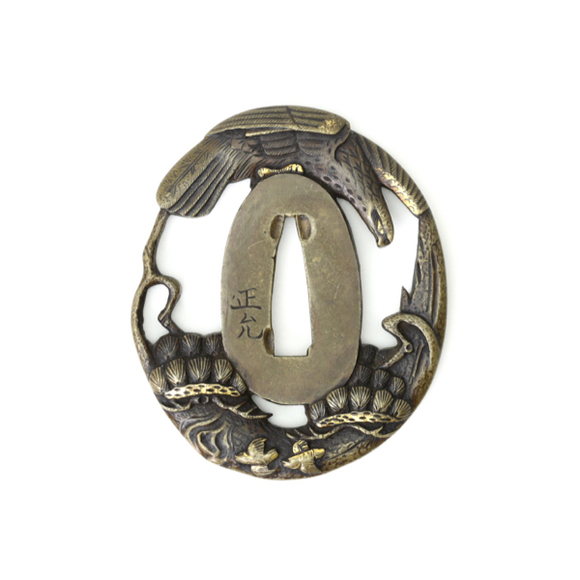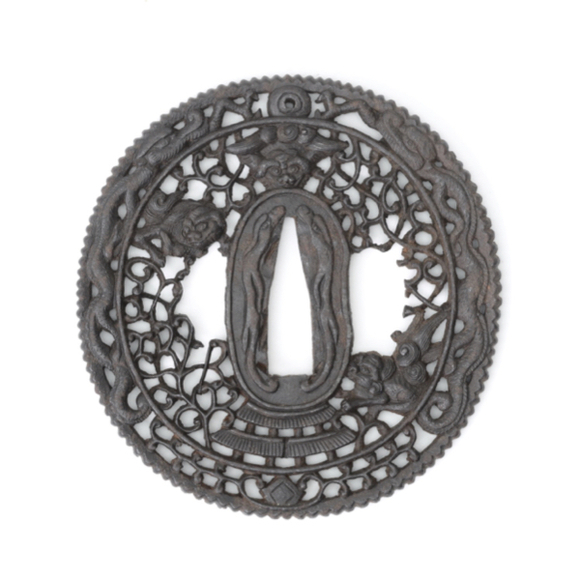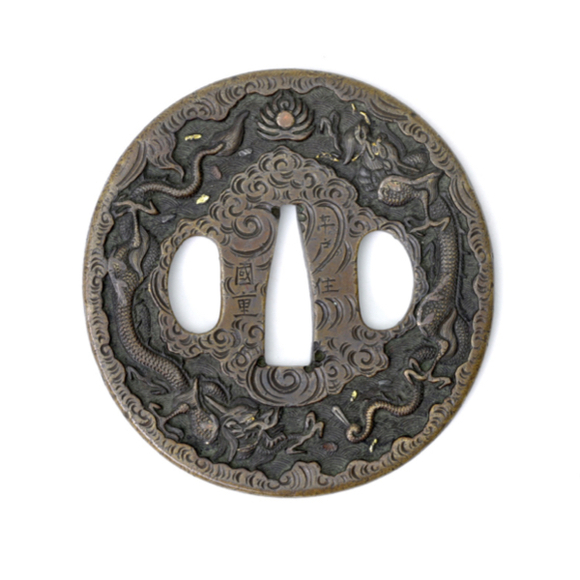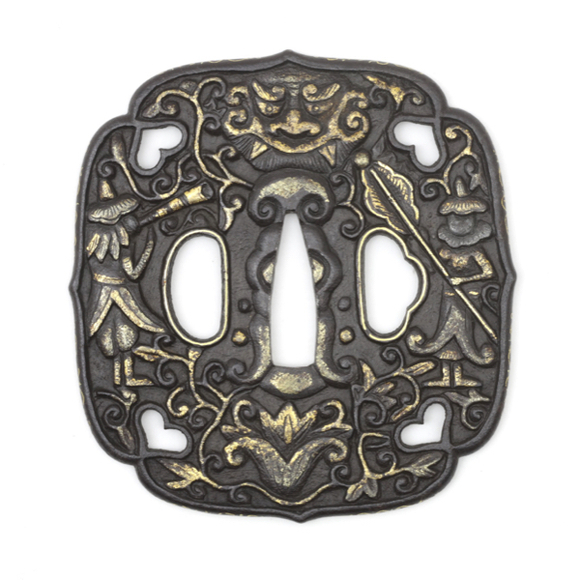Russet iron, one-piece construction with decorative grooves.

245.8 cm
(without scabbard)
Shaft 221.5 cm
Overall with tang 62.9 cm
Blade only 24.4 cm
Thickness at crossing 9 mm
Thickness at main kissaki 4 mm
With shaft 1823 grams
Head 382 grams
Spearhead; iron, steel
Shaft; wood, iron, copper alloys, urushi lacquer, gold
Nara, Japan
Head circa 1521-1555
Shaft probably 18th or 19th century
Introduction
The Kanabō school was a relatively small and isolated school of swordsmiths in Kanabōtsuji (金房辻) in Nara, Yamato province. The school's exact origins are unknown, but the earliest known Kanabō smiths were Tadayuki ((忠行), Masashige (正重), and Masazane (正真), all thought to have been active around the Eishō period of 1504-1521. The school was mainly active in the 16th century.
"They make stout sugata with wide mihaba and occasionally ō-kissaki, then temper hiro-suguha and ō-midare based on gunome differing from traditional Yamato-den of this province. Horimono like Ushiwaka and Benkei in Gojō Bridge is occasionally seen on their blades but does not look particularly refined.
They have gained a reputation as master yari makers and it is said that they had a contract with the Hōzō Temple (宝蔵院) for yari." 1
-Dr. Honma Junji, 1963
The Hōzō Temple is well known for its Hōzōin-ryū (宝蔵院流), a traditional Japanese martial arts school that specialized in spearmanship (sōjutsu). It was founded by Buddhist monk Hōzōin Kakuzenbō In'ei around 1560. Local lore has it that one evening he was looking at the reflection of the crescent moon on Sarusawa Pond in Kōfuku-ji. The shape inspired him to create a cross-shaped spearhead, now known as jumonji-yari (十文字槍). He then founded Hōzōin-ryū as the style of use for these spears.2
The school reached such fame that a young Miyamoto Musashi, considered Japan's best swordsman, went there to challenge them in 1605. Musashi was only 21 at the time while Hōzōin Kakuzenbō In'ei was already 84, and his successor 16. So they had another monk Okuzōin Dōei duel Musashi. Unlike many of Musashi's duels, this was a friendly match, and no-one died. Apparently, Musashi did win, but there was such mutual respect that he stayed, and talked with Kakuzenbō In'ei until dawn.
It is seen as a turning point in Musashi's life, as he usually attacked, won, and disappeared like a wild beast. From this moment onwards he became more cultured, and involved in the arts and literature. Musashi's school and the Hozoīn have remained on friendly terms ever since.
After the unification of Japan, Kakuzenbō In'ei left the martial path and in 1607 forbade the teaching of his spearmanship and sold much of the armory of the temple. His nephew Hōzōin Inshun revived the art after his death. Today, only some ruins of the Hōzōin remain in what is now Nara Park but its martial arts are still practiced.
Notes to introduction
1. Honma Junji; Nihon Koto Shi. 1963. Translated by Markus Sesko. Lulu Publishing. Available at Lulu.com. Page 238.
2. Official website of Hōzōin-ryū, hozoin.jp. Accessed April 24, 2023.
Description
Most jumonji-yari on today's market are revival pieces from the Shinto period, almost two centuries of peace. This jumonji-yari is a fine example of a larger Koto period piece, made for warrior monks who were active during a period of intense civil war.
Attributes
(With plain English below)
Jigane: Itame-hada with masame and ji nie.
(Steel: Regular wood grain with some straight grain. Some martensite crystals in the area above the temperline.)
Hamon: Midare in ko-nie-deki with some sunagashi
(Temperline: Undulating, appearing in mostly small martensite crystals. It has some brushed sand effects inside the tempered zone.)
Nakago: Ubu, 2 mekugi ana, zaimei.
(Tang: Unshortened, two peg holes. Signed.)
The blade has a small masa-ware (a harmless forging flaw running along the straight grain) on one side.
Signature
The nakago is signed with a long signature:
南都住金房隼人佐藤原正實
Nanto Ju Kanabō Hayato no Suke Fujiwara Masazane
Nanto (南都) is an alternative name for Nara, an old capital city in central Japan, south of Kyoto. Nanto Ju means "resident of Nara".
Kanabō (金房) is the name of the school, named after Kanabōtsuji, a village near Nara city.
Hayato no Suke (隼人佐) is an old title.
Fujiwara (藤原) is sometimes used as an honorary title, but in this case, it may also refer to the fact they actually came from Fujiwara in Yamato.
Masazane (正實) is, of course, the smith's name.
NBTHK Hozon papers
The signature on the nakago was verified by the NBTHK in Japan, who recently granted it a Hozon certificate, meaning it is authentic and "worthy of preservation." It is dated to the 25th day of the 8th month of the 4th year of Reiwa, corresponding to August 25, 2022.

The smith
Several Kanabō smiths signed Masazane, but this exact signature seems to correspond to the 1st generation who was active around 1521-1555.1
The first Masazane moved from Yamato Fujiwara to Kyōto to study under Heianjō Nagayoshi. He then accompanied his master to Ise province, where they worked with the Sengo school of the infamous Muramasa, whose blades would later get banned by the Tokugawa under the pretense of being cursed. He later moved to Mikawa and is also known to have worked in Sagami.
The smith who signed this yari is thought to have been the son of the Masazane of the introduction, who was less of a rolling stone and seemed to have settled and stayed in Kanabōtsuji. Hence, he is known as the 1st generation Kanabō Masazane.
He signed his name in two ways, either 正真 or 正實. The more elaborate way on this piece. The literature mentions several other Masazane smiths down the line who signed either one or the other. Knowing that the first generation already used them interchangeably, it is conceivable that this was just a habit done by the entire line, and some of these separately counted smiths could well be the same person.
There may have been a specific reason for using one or the other. The Bizen Osafune school of the same period, for example, was known to write their province either Bishū 備州 or Bizen Kuni 備前國, the former mostly on mass-produced swords and the latter generally seen on their better, more artistic swords. The Masazane smiths may have had a similar system in place.
Notes
1. Fujishiro puts this smith in the Daiei period of 1521-1532. Markus Sesko puts him in the Tenbun period of 1532-1555, as does Markus Sesko; Swordsmiths of Japan A-Z. Lulu Inc. 2015. Page 588. Fujishiro Matsuo; Nihon Toko Jiten. Koto Hen. Tokyo 1973. Page 393. Kataoka; Nihonto Zuikan. Koto volume. Page 276.
Koshirae
The spearhead comes with a finely made, full-length shaft that is lacquered in maki-e, a technique where gold powder is sprinkled over the wet lacquer. It is further decorated with floral motifs in gold and several family mon of crossed hawk feathers in a circle.
The mounts are darkened copper alloy, with a sturdy iron spike with a hexagonal cross-section on the opposite side of the head. The foreshaft is reinforced with several metal bands and cord wrappings.
The small collar piece at the end of the shaft is new, the original was lost, and I had this replacement made.
Conclusion
An impressive piece, made for war, by the prime makers of this style of polearms. They worked mainly for the local Buddhist warrior monks of the Hōzōin temple, who were known masters of the jumonji yari, famous throughout Japan.






























Unusual tsuba with foreign figures and Chinese auspicious symbols.






